After a brief run last year as a post-apocalyptic set in a zombie TV franchise, the Richmond Coliseum has become a go-to spot for homeless encampments.
It has sat dormant for most of the last two years, a casualty of the failed Navy Hill proposal.
But last week’s announcement about an arena-anchored development in the works in Henrico puts the future of the Coliseum land in a new light.
If the $2.3 billion GreenCity proposal and its 17,000-seat arena on the former Best Products site get a green light, city administrators said last week that, in such a scenario, they would not fight to keep a regional arena in Richmond. That would leave one less option for invigorating development of that part of downtown.
“We do not believe the region has the capacity to support two 17,000-seat arenas within 15 miles of each other, and should the GreenCity development win approval, we do not think it would make sense to pursue a similarly-anchored development within city limits,” administration spokesman Jim Nolan said in an email.
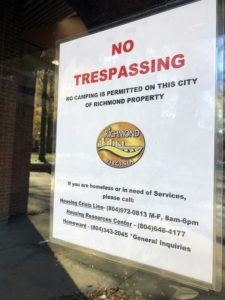
Signs on the doors of the Coliseum list phone numbers for homeless services. (Michael Schwartz photo)
“That being said, if the Henrico arena development is approved, then this provides a great opportunity to rethink our options to redevelop the Coliseum area,” Nolan said. “Leaving this underperforming downtown acreage undeveloped does not serve our long-term economic interests to generate revenue to fund priorities for our children and families, which is why, as the mayor says, we will boldly pursue opportunities to transform this valuable city-owned real estate.”
John Gerner, a leisure industry consultant who vice-chaired the City Council-appointed Navy Hill Development Advisory Commission, said the prospect of a downtown without an arena could prove to help the city in terms of determining how the land should be developed.
“In some ways, the situation in Henrico makes it even clearer,” Gerner said, “because if the Henrico announcement had not happened, we would still be under the possibility that there could be what had been talked about as ‘Navy Hill 2.0,’ in which the developers would come back with some variation of the original plan that would still have a new arena.”
The Navy Hill plan — designed by the same development team that’s behind GreenCity — was rejected in February by the City Council.
“With them clearly moving their arena project over to Henrico County, that in some ways actually makes things both clearer and simpler for the former Navy Hill parcels, because now they can move forward without the arena aspect,” Gerner said. “And since that was the sticking point, because of the bonds that would have needed to be issued to support the arena … once you take that away, it simply now becomes a much more conventional use of those parcels.”
Coliseum still costing the city
The aging half-century-old Coliseum has essentially been in zombie status for the past two years, ever since the city closed its doors at the start of 2019 while Navy Hill was under consideration. At the time, city administrators said the closure would reduce an operating deficit that, with fewer events being booked at the Coliseum, was costing the city $1.5 million annually.
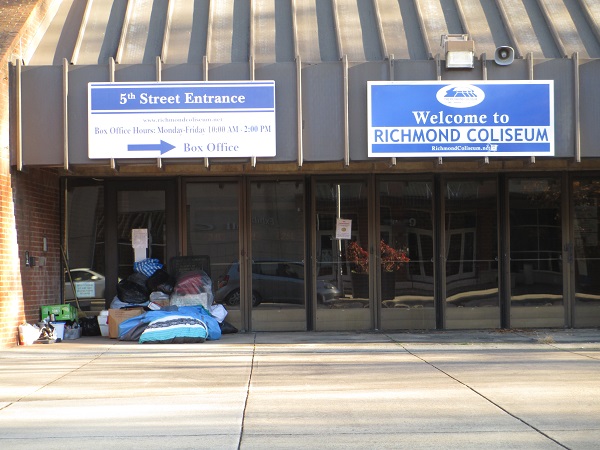
Items from homeless encampments are visible around the Coliseum’s perimeter. (Jonathan Spiers photo)
While that deficit is now significantly reduced, the Coliseum is still an expense for the city — costing about $250,000 annually. Nolan said those costs include about $150,000 for utilities and $100,000 for other expenses, including armed security.
The city also is still paying down remaining outstanding debt on the Coliseum, with six payments left to be made through 2023. Principal and interest payments over that time are budgeted to total more than $1.5 million, according to the city.
City Councilmember Kristen Larson, who was among a majority of councilmembers who voted down the Navy Hill plan in February, said the Coliseum’s costs need to be addressed.
“We need to look at getting that off our books,” Larson said. “Any sort of vacant space that we have that is sucking money out of the general fund coffers, we need to look at what we can do to move that off our books in a fiscally smart way.”
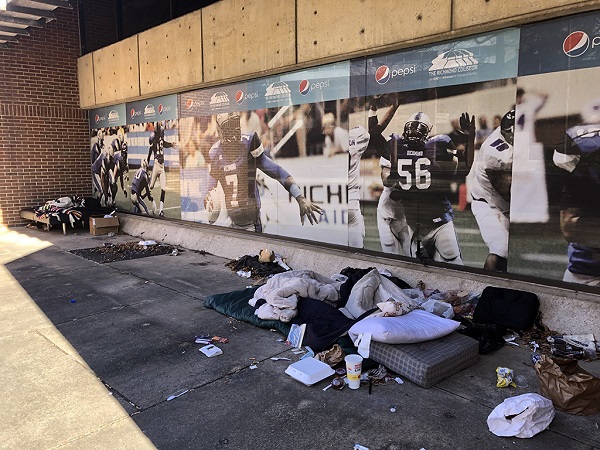
Billboards for the former Richmond Raiders indoor football team contrast the Coliseum’s past and present. (Michael Schwartz photo)
Part of this year’s operating costs went toward erecting new fencing at the below-grade Leigh Street entrance, which had attracted homeless encampments. Other encampments have been regularly popping up under the entrance awnings around the Coliseum’s perimeter, despite “No trespassing” signs the city posted on the doors prohibiting camping on the property.
The signs include phone numbers for support agency Homeward and other area homeless services. The city also is looking to identify a location for a new inclement weather shelter in light of the previous homeless shelter’s closure due to COVID-19. A resolution to that effect, co-patroned by Larson and Kim Gray, is headed to the council next week.
Plan in the works
Since Navy Hill, city officials have been working toward achieving benchmarks laid out in a council resolution, including development of a Coliseum-specific small area plan with community input, and appraisals of the properties involved that have since been conducted.
The requested small area plan has been in the works in conjunction with the Richmond 300 master plan update, which the council is scheduled to vote on at its Dec. 14 meeting. Nolan, the city spokesman, said the Coliseum plan would be completed after the holidays, with potential adoption next spring as an amendment to Richmond 300.
Additional community meetings to solicit input on the plan are to be held by then, adding to two virtual meetings that were held over the summer and provided indications of public preference for the area.
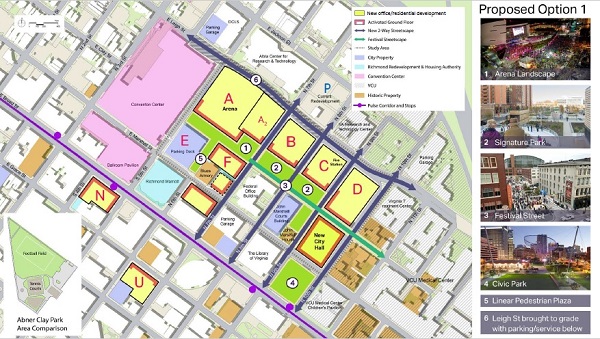
A conceptual map shows how a city park and greenspace could be incorporated into the Coliseum area’s development. (Courtesy of Richmond 300)
The so-called Coliseum Area Framework Plan, which would inform a formal request for proposals, is shaped around the concept of a “mixed-use destination” that would add to the city’s tax base and include regional attractions. Baseline elements in the plan include public open space, including green space that would form an area park.
A survey conducted in June found that responses from 879 respondents were generally supportive of such uses as dining, a city market, shopping and a cinema.
About 15 percent said they hated the idea of a sports arena there, while 45 percent said they hated the idea of a casino — another economic development opportunity that the city is currently mulling.
The survey also found support for a proposed redevelopment of the city’s Public Safety Building, which was among the properties involved in Navy Hill. A newer, separate proposal for that building, by the same team behind Navy Hill and GreenCity, calls for a mixed-use development with a 20-story, VCU-anchored tower.
Gerner said the revival of that portion of Navy Hill bodes well for the other properties, including the prospect of a much-discussed hotel to complement the Greater Richmond Convention Center.
“That shows by itself that at least parts of the original Navy Hill plan can still continue to happen,” Gerner said. “It was not my understanding that a convention center hotel was undoable unless there was an arena, so that’s still, as far as I know, a possibility — once, of course, we get back to a situation where the city is generating a significant number of conventions.”
Demolition a costly option
Beyond addressing homeless encampments at the Coliseum and in adjacent Festival Park, some councilmembers say the structure is an eyesore and potential liability that needs to be addressed.
“We need an update on the status and the condition of the existing Coliseum,” Gray said. “It’s definitely a blight. It’s definitely a concern.”
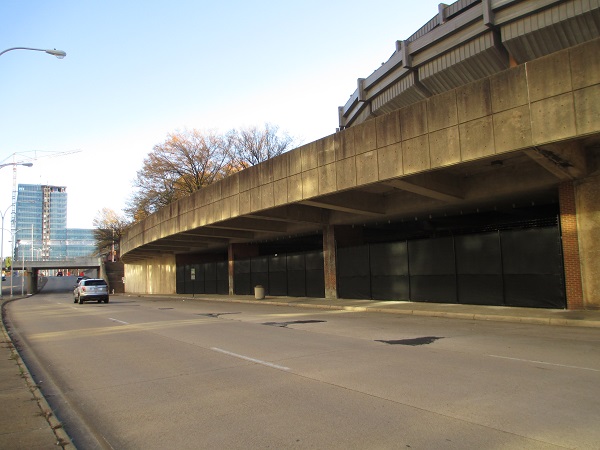
The Leigh Street entrance was fenced off this year to prevent homeless encampments that had popped up in recent months. (Jonathan Spiers photo)
The Navy Hill plan called for demolishing the 13,500-seat Coliseum and replacing it with a 17,500-seat arena. Demolition remains an option for clearing the way for new development, though some developers including Douglas Development have proposed that the Coliseum could be rehabbed and incorporated into a new development.
Michael Hallmark, the principal with Richmond-based Future Cities who with developer Susan Eastridge designed Navy Hill and is proposing GreenCity and the VCU-anchored tower on the Public Safety Building site, said city estimates at the time that Navy Hill was being considered put the cost of demolition between $8 million and $12 million. He said Navy Hill was structured to absorb that cost as part of the larger, arena-driven development.
“We believe the arena was necessary to get the kind of privately funded infrastructure development done to attract enough use for a convention center hotel and those kinds of uses,” Hallmark said. “Those things generally are underwritten by cities, convention center hotels especially.”
He added, “I presume there will be more traditional uses envisioned there in the future. Certainly getting more residential downtown will be important, and perhaps some discreet office uses.”
While the VCU tower would essentially salvage the Public Safety Building portion of Navy Hill, Hallmark said he and Eastridge are not looking to develop any of the other parcels.
“Our focus in downtown is 100 percent on the Public Safety Building. It’s an important project to get done, and we’re laser-focused on trying to advance that as fast we can. There’s a lot of noble organizations, like Ronald McDonald House and Doorways, that are desperate to be in these new facilities, so we don’t want any distractions from that at all.”
With Hallmark and Eastridge’s focus also on GreenCity and the $250 million arena that would anchor it, Richmond’s planning efforts for downtown can move forward without the weight of a regional arena being involved, Gerner said.
“Because of the move to Henrico, this now makes the Coliseum a situation where the city can now decide that it is no longer expected to be the host of a regional arena,” he said. “Without that understanding with the surrounding counties, which it has had for decades, the city is now free to look at what is the highest and best use of those parcels for the city.”
Despite the pandemic’s impacts on arenas worldwide and the hospitality and leisure industry in general, Gerner said the conditions are an opportune time for Richmond to set the stage for what’s next for the Coliseum area.
“This really is the best time to be doing planning for the next stage, because it takes time to do that planning and to get things into place, and there are benefits to being ready-to-go, shovel-ready, once we are clearly in a post-COVID world again,” he said. “In some ways, that’s the optimum time to be doing projects of all kinds, because there’s going to be pent-up demand.”
After a brief run last year as a post-apocalyptic set in a zombie TV franchise, the Richmond Coliseum has become a go-to spot for homeless encampments.
It has sat dormant for most of the last two years, a casualty of the failed Navy Hill proposal.
But last week’s announcement about an arena-anchored development in the works in Henrico puts the future of the Coliseum land in a new light.
If the $2.3 billion GreenCity proposal and its 17,000-seat arena on the former Best Products site get a green light, city administrators said last week that, in such a scenario, they would not fight to keep a regional arena in Richmond. That would leave one less option for invigorating development of that part of downtown.
“We do not believe the region has the capacity to support two 17,000-seat arenas within 15 miles of each other, and should the GreenCity development win approval, we do not think it would make sense to pursue a similarly-anchored development within city limits,” administration spokesman Jim Nolan said in an email.

Signs on the doors of the Coliseum list phone numbers for homeless services. (Michael Schwartz photo)
“That being said, if the Henrico arena development is approved, then this provides a great opportunity to rethink our options to redevelop the Coliseum area,” Nolan said. “Leaving this underperforming downtown acreage undeveloped does not serve our long-term economic interests to generate revenue to fund priorities for our children and families, which is why, as the mayor says, we will boldly pursue opportunities to transform this valuable city-owned real estate.”
John Gerner, a leisure industry consultant who vice-chaired the City Council-appointed Navy Hill Development Advisory Commission, said the prospect of a downtown without an arena could prove to help the city in terms of determining how the land should be developed.
“In some ways, the situation in Henrico makes it even clearer,” Gerner said, “because if the Henrico announcement had not happened, we would still be under the possibility that there could be what had been talked about as ‘Navy Hill 2.0,’ in which the developers would come back with some variation of the original plan that would still have a new arena.”
The Navy Hill plan — designed by the same development team that’s behind GreenCity — was rejected in February by the City Council.
“With them clearly moving their arena project over to Henrico County, that in some ways actually makes things both clearer and simpler for the former Navy Hill parcels, because now they can move forward without the arena aspect,” Gerner said. “And since that was the sticking point, because of the bonds that would have needed to be issued to support the arena … once you take that away, it simply now becomes a much more conventional use of those parcels.”
Coliseum still costing the city
The aging half-century-old Coliseum has essentially been in zombie status for the past two years, ever since the city closed its doors at the start of 2019 while Navy Hill was under consideration. At the time, city administrators said the closure would reduce an operating deficit that, with fewer events being booked at the Coliseum, was costing the city $1.5 million annually.

Items from homeless encampments are visible around the Coliseum’s perimeter. (Jonathan Spiers photo)
While that deficit is now significantly reduced, the Coliseum is still an expense for the city — costing about $250,000 annually. Nolan said those costs include about $150,000 for utilities and $100,000 for other expenses, including armed security.
The city also is still paying down remaining outstanding debt on the Coliseum, with six payments left to be made through 2023. Principal and interest payments over that time are budgeted to total more than $1.5 million, according to the city.
City Councilmember Kristen Larson, who was among a majority of councilmembers who voted down the Navy Hill plan in February, said the Coliseum’s costs need to be addressed.
“We need to look at getting that off our books,” Larson said. “Any sort of vacant space that we have that is sucking money out of the general fund coffers, we need to look at what we can do to move that off our books in a fiscally smart way.”

Billboards for the former Richmond Raiders indoor football team contrast the Coliseum’s past and present. (Michael Schwartz photo)
Part of this year’s operating costs went toward erecting new fencing at the below-grade Leigh Street entrance, which had attracted homeless encampments. Other encampments have been regularly popping up under the entrance awnings around the Coliseum’s perimeter, despite “No trespassing” signs the city posted on the doors prohibiting camping on the property.
The signs include phone numbers for support agency Homeward and other area homeless services. The city also is looking to identify a location for a new inclement weather shelter in light of the previous homeless shelter’s closure due to COVID-19. A resolution to that effect, co-patroned by Larson and Kim Gray, is headed to the council next week.
Plan in the works
Since Navy Hill, city officials have been working toward achieving benchmarks laid out in a council resolution, including development of a Coliseum-specific small area plan with community input, and appraisals of the properties involved that have since been conducted.
The requested small area plan has been in the works in conjunction with the Richmond 300 master plan update, which the council is scheduled to vote on at its Dec. 14 meeting. Nolan, the city spokesman, said the Coliseum plan would be completed after the holidays, with potential adoption next spring as an amendment to Richmond 300.
Additional community meetings to solicit input on the plan are to be held by then, adding to two virtual meetings that were held over the summer and provided indications of public preference for the area.

A conceptual map shows how a city park and greenspace could be incorporated into the Coliseum area’s development. (Courtesy of Richmond 300)
The so-called Coliseum Area Framework Plan, which would inform a formal request for proposals, is shaped around the concept of a “mixed-use destination” that would add to the city’s tax base and include regional attractions. Baseline elements in the plan include public open space, including green space that would form an area park.
A survey conducted in June found that responses from 879 respondents were generally supportive of such uses as dining, a city market, shopping and a cinema.
About 15 percent said they hated the idea of a sports arena there, while 45 percent said they hated the idea of a casino — another economic development opportunity that the city is currently mulling.
The survey also found support for a proposed redevelopment of the city’s Public Safety Building, which was among the properties involved in Navy Hill. A newer, separate proposal for that building, by the same team behind Navy Hill and GreenCity, calls for a mixed-use development with a 20-story, VCU-anchored tower.
Gerner said the revival of that portion of Navy Hill bodes well for the other properties, including the prospect of a much-discussed hotel to complement the Greater Richmond Convention Center.
“That shows by itself that at least parts of the original Navy Hill plan can still continue to happen,” Gerner said. “It was not my understanding that a convention center hotel was undoable unless there was an arena, so that’s still, as far as I know, a possibility — once, of course, we get back to a situation where the city is generating a significant number of conventions.”
Demolition a costly option
Beyond addressing homeless encampments at the Coliseum and in adjacent Festival Park, some councilmembers say the structure is an eyesore and potential liability that needs to be addressed.
“We need an update on the status and the condition of the existing Coliseum,” Gray said. “It’s definitely a blight. It’s definitely a concern.”

The Leigh Street entrance was fenced off this year to prevent homeless encampments that had popped up in recent months. (Jonathan Spiers photo)
The Navy Hill plan called for demolishing the 13,500-seat Coliseum and replacing it with a 17,500-seat arena. Demolition remains an option for clearing the way for new development, though some developers including Douglas Development have proposed that the Coliseum could be rehabbed and incorporated into a new development.
Michael Hallmark, the principal with Richmond-based Future Cities who with developer Susan Eastridge designed Navy Hill and is proposing GreenCity and the VCU-anchored tower on the Public Safety Building site, said city estimates at the time that Navy Hill was being considered put the cost of demolition between $8 million and $12 million. He said Navy Hill was structured to absorb that cost as part of the larger, arena-driven development.
“We believe the arena was necessary to get the kind of privately funded infrastructure development done to attract enough use for a convention center hotel and those kinds of uses,” Hallmark said. “Those things generally are underwritten by cities, convention center hotels especially.”
He added, “I presume there will be more traditional uses envisioned there in the future. Certainly getting more residential downtown will be important, and perhaps some discreet office uses.”
While the VCU tower would essentially salvage the Public Safety Building portion of Navy Hill, Hallmark said he and Eastridge are not looking to develop any of the other parcels.
“Our focus in downtown is 100 percent on the Public Safety Building. It’s an important project to get done, and we’re laser-focused on trying to advance that as fast we can. There’s a lot of noble organizations, like Ronald McDonald House and Doorways, that are desperate to be in these new facilities, so we don’t want any distractions from that at all.”
With Hallmark and Eastridge’s focus also on GreenCity and the $250 million arena that would anchor it, Richmond’s planning efforts for downtown can move forward without the weight of a regional arena being involved, Gerner said.
“Because of the move to Henrico, this now makes the Coliseum a situation where the city can now decide that it is no longer expected to be the host of a regional arena,” he said. “Without that understanding with the surrounding counties, which it has had for decades, the city is now free to look at what is the highest and best use of those parcels for the city.”
Despite the pandemic’s impacts on arenas worldwide and the hospitality and leisure industry in general, Gerner said the conditions are an opportune time for Richmond to set the stage for what’s next for the Coliseum area.
“This really is the best time to be doing planning for the next stage, because it takes time to do that planning and to get things into place, and there are benefits to being ready-to-go, shovel-ready, once we are clearly in a post-COVID world again,” he said. “In some ways, that’s the optimum time to be doing projects of all kinds, because there’s going to be pent-up demand.”
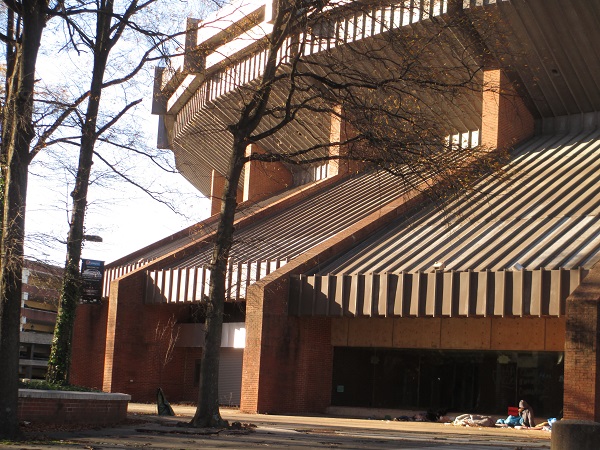
Excellent article, thank you.
It is quite surreal to think a man who has no vested interest in Richmond – as in he owns zero property here, does not have family ties here, and is only living in Richmond due to work – had the ability to shut down our functional entertainment hub.
While I am not opposed to the idea that the City would be without an arena, I will never forget why. Cronyism. Ego. Political power play.
I feel for future VCU,VSU, etc graduates who will be forced to celebrate in the suburbs.
Calling The Coliseum our “entertainment hub” and saying Stoney shut it down is not in touch with reality. I don’t know of anyone who went there aside from the now bankrupt circus and the week/2 week long Jehovah’s witness annual convention. While I did not want the debt from Navy Hill’s arena for Richmond, I did want the demolition and ancillary development planned around the arena. Stoney did push too far with the arena, but I blame city government for that area involved being dead for this long. Stoney has a lot of room for improvement and I agree he… Read more »
Hi Justin, If I could share some events that many thousands of unique visitors enjoyed in the twelve months prior to the City, specifically our Mayor, shutting down the Coliseum: • Snoop Dogg/Bones Thugs Concert • Richmond Raiders games (and they held operatioms out of the Coliseum) • VCU Commencement • NCAA Basketball • Tim McGrath Concert • Garth Brooks Concert • Kevin Hart Comedy tour Labeling me out of touch with reality and then shorting the magnitude of events/usage of the Coliseum in with a brief list seems disingenuous. I do appreciate you sharing events I was unaware of.… Read more »
Ashley – that list of events for an entire 12 months is not very impressive. The new arena was going to cost $20 million per year for 30 years just to service the debt. Nevermind the maintenance expenses that would crop up. And this funding was going to accomplished by taking incremental tax revenue (TIF) for 30 blocks of the city and funneling towards this project. Effectively strangling growth of the general fund that pays for basic city services. Those events probably contribute less than 1.5 million in incremental tax revenue which is a drop in the bucket. Hence why… Read more »
The City can and will grow organically without “major projects” that saddle it with longterm debt that needs to be targeted to educating its youth and providing affordable housing for its residents. The City has issues for sure but the growth of VCU has stabilized it and pushed it past the tipping point for further growth. Virginia is one of only four states in which the cities are not within a county. That separatism, created for whatever reason, has been a costly sticking point for all kinds of issues, but that’s NOT the Dillon Rule if that was intended by… Read more »
The state of the Coliseum is an embarrassment to the City of Richmond. We spend more per student on education yet have the lowest scores in the Region. Drive down Monument Avenue (now deemed “pedestal avenue”) and then over to the Coliseum and you see “first hand” that we have one of the worst city governments in the US. Our politicians say all of the politically correct things yet nothing gets done. There is no action and no accountability. Navy Hill was a phenomenal opportunity to redevelop the Coliseum area yet the ignorance of our mayor and city council was… Read more »
So true Mike – I live in the Fan, and I am very seriously considering moving to the counties. Three big reasons – my taxes have increased by $1500 in two years (!!!), ugliness (my roads aren’t paved/limited graffiti cleanup/pedestals not removed), and the planning department and city government not being responsive to our concerns. You can’t have my money forever – the pretty architecture of the city may not be enough to keep me here if the city is run so terribly.
What a great place to build a specialty high school focusing on Bio-tech and Health Sciences. Partner with JSR, VCU, and the myriad neighborhood private health and bio-tech firms to provide advanced classes and OJT/Internships/Apprenticeships. Richmond students could graduate with a health aide certification, and associate’s degree or several college credits, which would make getting a degree more affordable. This would be a good use of part of the location, freeing up the rest for high density mixed-income, mixed-use development, while making Richmond a destination for families wanting to give their children an educational leg up on careers in growing,… Read more »
A beautiful, large parking deck will work well in that space, and isn’t that what Richmond residents want? We just can’t get past the “It costs too much” thing. A new “complex” of any type may well be taken out of Richmond resident’s hands.
Goodbye to what could have been.
Really enjoyed the article. It seems there are no good solutions to the Coliseum issue. Although it has been a long time since I went there, it was quite pleasant to be able to meet at one of the local establishments and then take in an event. I would be sorry it that were no longer an option. However, if Green City does become real, than the Coliseum needs to be torn down or converted into offices, flats, and shops. As it is now it is a ball and chain on RVA.
The City of Richmond really screwed the pooch on this one. Whenever the topic of the now defunct “Navy Hill project” comes up all I can think of is the city council being “too tired” to make a rational decision. The blight of Richmond is upon us while council sleeps…
Not sure what the issue is -leave it for the homeless as well as those that have destroyed the potential the downtown area “USED’ to have,,poof! I look forward to attending events at the new Henrico Center.
I really think all of Richmond’s streets and sidewalks should be taken out of city control and merged into Vdot to get them to pave and fix pot holes and sidewalks.
It’s not uncommon to have vdot fix something with in 24 hours of reporting it.
As I said in an earlier post the City should demolish the Coliseum sooner rather than later, even at a cost of between $8 and 12 million. The city will recoup that money when it ultimately sells the land to a developer. In the interim it will eliminate the $250 thousand dollars per year in continuing costs, which is low , but a cost nevertheless. It will also eliminate an eyesore and deter the homeless from camping out, when they can go to a shelter as better, and safer, alternative.
If you feel the need to keep up with the Jonses you’ll never be able to. Henrico is a fine choice for an arena. Richmond City doesn’t need an arena to attract residents, investments, & tax dollars. Patience.
We are the largest metro area in the United States without a major entertainment venue. Is every other major city wrong and we are right. I think NOT. The Navy Hill project was financed primarily through private funds with very little risk to the city. It was a GREAT deal. Putting affordable housing there – that’s downright ridiculous and defies economic reasoning. I’m embarrassed for the mayor and City council and it’s thinking like yours (patience????) that have us paralyzed.
Tell me Mike what is the MAJOR entertainment venue in Hampton Roads?? Would that be the Norfolk Scope or the Hampton Coliseum both as old as our closed Coliseum. And Norfolk-VA Beach is a LARGER metro area than RVA. They tried to build a 18,000 seat coliseum/arena by the VA Beach Convention Center. Funny that was all private dollars and little risk too. Funny how conservative, fiscally well run VAB could see through the smoke and mirrors smartly pulling the plug when the realized it was a sham.
Virginia Beach agreed to reimburse the developer $45 million. I’m not sure how that was “all private dollars”.
https://www.yesvirginiabeach.com/Resources/Documents/007_Arena%20-%20Cost%20Participation%20Agreement%20SUMMARY%20(11.6.15).pdf
The City of Richmond should sell the Coliseum to a private entity with the conditions that they build a new multi-sport stadium (baseball, soccer, and football) in its’ spot. Rebkee came with a proposal to build a new baseball stadium years ago that would have been 100% privately done with no tax dollars involved. They should do that here. It would eliminate the Coliseum – cut the losses of it, bring forms of entertainment back to this part of Richmond, and free up the Boulevard for the development/tax revenues the City of Richmond initially wanted.
And privately done – as well. No public funding.
Henrico Chesterfield Hanover and Goochland have propped up the city of Richmond for years.If the same folks running Henrico the last 40 years would have been running the city, Richmond would rival Atlanta right now. Not saying I want it that big but Richmond city council and government have been a laughing stock since the mid 70’s. On top of it you re-elect a mayor who protected rioters and let them destroy businesses and private property for months.
You made your own bed.
Good luck to Henrico on their arena.